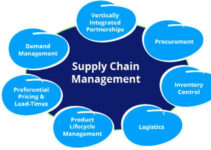KPIs (key performance indicators) are the quantitative measuring units that would help you to analyze the performance of your business over time. They allow you to evaluate and analyze how effectively the company is achieving its goals and objectives. However, Omnichannel SC allows companies to sell their products via all sales channels. Today, we’ll discuss supply chain management KPIs; their definition, and some of the top key performance indicators.
What are Supply Chain Management KPIs?
In order to define supply chain management KPIs, it is significant that you should establish some particular performance parameters that you need to track the operations of the company. Those parameters would offer you key insight into the inventory velocity, inventory-to-sales ratio, and inventory turnover.
The KPIs would serve as benchmarking criteria that would help you to analyze and track the operational metrics of your company and lets you know how effectively the company is achieving its targets. It allows you to predict future demand and sales based on the previous progress you have made.
KPIs would make things easier for you if you are planning to perform the following functions;
- Making business decisions relevant to expansion and development
- Amplifying the company’s warehousing management, shipping operations, and order fulfillment
Supply Chain Management KPIs
Some of the top supply chain management KPIs are as follows;
Inventory Days of Supply
It is the time period during which your inventory could sustain without restocking it. This KPI allows you to monitor your inventory level in the warehouse so that you could replenish it just in time before the demand hits high. It would help you to save investment and reputation and avoid stock-related catastrophes.
You can analyze and evaluate the daily information and take various actions to refill your stock promptly. Here’s how you can calculate it;
Inventory Days of Supply = Inventory in Hand / Average Daily Usage of Inventory
Fill Rate
It is a very critical SCM KPI and it allows you to analyze the order fulfillment and line fulfill rate. It focuses on successfully shipping a percentage of SKUs or packages on the first attempt.
- Unit Fill: Analyzing the products delivered on the first shipment
- Line Fill: Evaluating the delivery of line items on the first shipment
- Order Fill: Analyzing the completion of orders on the first shipment
The formula to calculate the fill rate is as follows;
Fill Rate = (Total Number of Items – Number of Shipped Items) / Total Number of Items * 100
Customer Order Cycle Time
This KPI would offer you a key insight relevant to product, service, or SC responsiveness. It outlines the time period between the purchase orders received from customers and the order delivered to the customers. However, if the cash-to-cash cycle is increasing and the customer order isn’t, then it shows the problem with the former. It allows you to analyze the account receivable, accounts payable, and invoicing times.
Customer Order Cycle Time = Actual Delivery Date – Purchase Order Creation Date
In case of variation and calculating the promised results, then use the following;
Customer Order Cycle Time = Requested Delivery Date – Purchase Order Creation Date
Cash to Cash Cycle Time
This KPI focuses on the financial ratios and outlines the key insights about the SC operations of the company. It exhibits the time its takes between raw material payment and receiving payment for selling the product. The low value of this indicator would show high profitability and leanness. It means that your delivery service and shortage have got good health, because of limited operational capital invested for a short time.
Cash to Cash Cycle Time = Material Payment Data – Customer Order Payment Date
Perfect Order
The perfect order KPI is a combination of significant metrics and they offer you a key insight into various areas of your order fulfillment process. It allows you to measure delivery and shortage operations, customer satisfaction level, and manage costs. However, it comprises of following elements;
- Timely delivery
- In-full delivery
- Damage-free delivery
- Accurate documentation
For instance, if you have got a low value on damage-free and on-time delivery, then it means that your customers are receiving the orders on time. This element would exhibit offering refunds to the customers, and the extra incurred cost for refunds.
Perfect Order = Total Number of Orders – Number of Error Orders / Total Number of Orders * 100
Inventory Velocity
This KPI would help you to know the required inventory to complete the task in the given time. it is a very important KPI and it helps you in the following ways;
- Offers you key insight into warehousing operations
- Optimizing inventory level
- Effectively satisfying customer demands
- Decreasing the risk of excessive obsolete inventory
Inventory Velocity = Opening Stock Level / Next Period Sales Forecast
Gross Margin Return on Investment
GMROI KPI provides you with information about the revenue and profitability of your business entity. It informs you about the capital you have earned by making an investment in the inventory. However, it allows you to recognize the slow-moving products and goods in the inventory by analyzing GMROI and employs this insight to amplify the planning, production, and warehousing operations of your business.
GMROI = 100 * Gross Profit / ((open stock – closing stock) /2)
Inventory Turnover
Inventory KPI offers you key insight into the number of times you have sold your inventory in a particular period. It allows you to measure and analyze the production processes, sales and marketing operations, and order fulfillment.
Inventory Turnover Ratio = Cost of Goods Sold / (open stock – closing stock / 2)
Days Sales Outstanding
This KPI allows you how quickly and speedily you can receive payments from customers. If the value of DSO is low, then it is a very good and effective sign of financial health. It indicates that it would take you a limited time to generate revenue and profit from your customers. On the other hand, a high DSO value means that it would take you a lot of time to gather account receivable. It results in the form of slowing down the cash flow and negatively impacting the outcome.
Day Sale Outstanding = Days in Period * (Account receivable / sales)
Freight Bill Accuracy
It comprises shipping and transporting your inventory from the production facility to the warehouse. It plays a key role in streamlining your operations; some errors and mistakes would jeopardize your cash flow and business reputation.
Freight Bill Accuracy = (Number of Correct Freight Bills / Total Freight Bills) * 100
Conclusion: Supply Chain Management KPIs
After an in-depth study of the supply chain management KPIs; we have realized that key performance indicators are significant to measure your growth and performance. If you are learning about the SCM KPIs, then you should keep in mind the abovementioned key performance indicators and metrics.
References
Ahsan is an accomplished researcher and has a deep insight in worldly life affairs. He goes Live 3 days a week on various social media platforms. Other than research writing, he’s a very interesting person.


